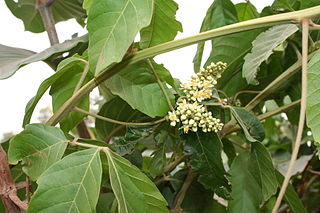
KalanchoeKAL-ən-KOH-ee, also written Kalanchöe or Kalanchoë, is a genus of about 125 species of tropical, succulent plants in the stonecrop family Crassulaceae, mainly native to Madagascar and tropical Africa. A Kalanchoe species was one of the first plants to be sent into space, sent on a resupply to the Soviet Salyut 1 space station in 1979. Kalanchoes require direct sunlight although they can survive with bright indirect sunlight. They only need to be watered when the soil is completely dry.

Psoralea is a genus in the legume family (Fabaceae) with over 60 closely related species native to southern Africa. In South Africa they are commonly referred to as fountainbush (English); fonteinbos, bloukeur, or penwortel (Afrikaans); and umHlonishwa (Zulu).

Paullinia is a genus of flowering shrubs, small trees and lianas in the soapberry family, Sapindaceae, native to tropical South America, Central America and the Caribbean.

Arenga pinnata is an economically important feather palm native to tropical Asia, from eastern India east to Malaysia, Indonesia, and the Philippines in the east. Common names include sugar palm, areng palm, black sugar palm, and kaong palm, among other names.

Staphylea, called bladdernuts, is a small genus of 10 or 11 species of flowering plants in the family Staphyleaceae, native to temperate regions of the Northern Hemisphere. The highest species diversity is in China, where four species occur.
Pongamia oil is derived from the seeds of the Millettia pinnata tree, which is native to tropical and temperate Asia. Millettia pinnata, also known as Pongamia pinnata or Pongamia glabra, is common throughout Asia and thus has many different names in different languages, many of which have come to be used in English to describe the seed oil derived from M. pinnata; Pongamia is often used as the generic name for the tree and is derived from the genus the tree was originally placed in. Other names for this oil include honge oil, kanuga oil, karanja oil, and pungai oil.

Millettia pinnata is a species of tree in the pea family, Fabaceae, native to eastern and tropical Asia, Australia, and Pacific islands. It is often known by the synonym Pongamia pinnata. Its common names include Indian beech and Pongame oiltree.

Nekemias arborea, commonly known as pepper vine, is native to the Southeastern United States, Texas, and New Mexico. It spreads rapidly, climbing up trees and bushes.

Millettia is a genus of legume in the family Fabaceae. It consists of about 150 species, which are distributed in the tropical and subtropical regions of the world. The genus was formerly known by the name Pongamia, but that name was rejected in favor of the name Millettia, and many species have been reclassified. Due to recent interest in biofuels, Pongamia is often the generic name used when referring to Millettia pinnata, a tree being explored for producing biodiesel.
Roupala pinnata is a species of plant in the family Proteaceae. It is endemic to Peru.

Kalanchoe pinnata, formerly known as Bryophyllum pinnatum, also known as the air plant, cathedral bells, life plant, miracle leaf, and Goethe plant is a succulent plant native to Madagascar, which is a popular houseplant and has become naturalized in tropical and subtropical areas. It is distinctive for the profusion of miniature plantlets that form on the margins of its phylloclades, a trait it has in common with some other members of Bryophyllum.

Serruria, or spiderhead is a genus of flowering plants in the family Proteaceae, endemic to South Africa.

Azolla pinnata is a species of fern known by several common names, including mosquitofern, feathered mosquitofern and water velvet. It is native to much of Africa, Asia and parts of Australia. It is an aquatic plant, it is found floating upon the surface of the water. It grows in quiet and slow-moving water bodies, because swift currents and waves break up the plant. At maximum growth rate, it can double its biomass in 1.9 days, with most strains attaining such growth within a week under optimal conditions.

Pometia pinnata is a large tropical hardwood and fruit tree species, with common names including matoa, taun tree, island lychee, tava, Pacific lychee of the plant family Sapindaceae.

Paullinia pinnata is a flowering plant species in the genus of Paullinia found in South America and Africa.

Staphylea pinnata, the European bladdernut, is a species of bladdernut native to Europe and naturalized in Britain.
Walsura pinnata is a tree in the family Meliaceae. The specific epithet pinnata is from the Latin meaning "feather-like", referring to the leaves.

Garuga pinnata is a deciduous tree species from the family Burseraceae.

Spondias pinnata, sometimes also known as hog plum, is a species of tree with edible sour fruits. It is native to the Philippines and Indonesia, but has been widely naturalized in South Asia, Mainland Southeast Asia, Southern China, and the Solomon Islands. It belongs to the family Anacardiaceae. This species, among several others, has sometimes called the "wild mango" in other languages and was once placed in the genus Mangifera. It is found in lowlands and hill forests up to 1,200 m (3,900 ft).
Synaphea pinnata, commonly known as Helena synaphea, is a shrub endemic to Western Australia.
















